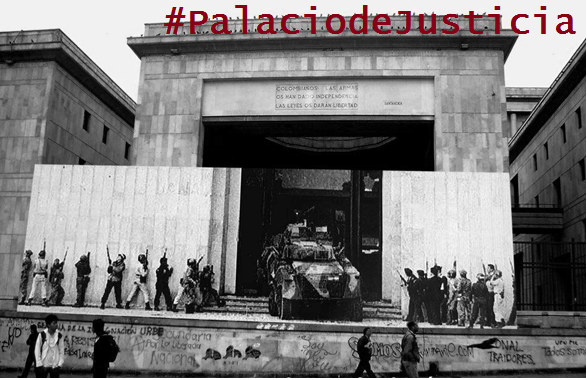






On November 6, 1985, the Ivan Marino Ospina commando of the M-19 guerilla group lay siege to Colombia’s Palace of Justice, seat of the country’s Supreme Court, which stands in the heart of the capital city of Bogota.
Although the military already had received intelligence reports since August indicating that the M-19 would take the Palace, security staff provided by the National Police were withdrawn two days before the attack was launched without any prior notice.
After the seizure, the high command of the Armed Forces of Colombia decided to take back the palace through a 27-hours long counter-siege. During the course of the military operative, 12 people were forcibly disappeared, 4 were tortured and an auxiliary judge was also forcibly disappeared and extrajudicially executed by members of the armed forces. In total, over 90 people died once the counter-siege military operation had concluded.
In 1991, the families of the victims filed their first complaint with the Inter-American Commission on Human Rights (IACHR). Starting in 2000, CEJIL, Colectivo de Abogados “José Alvear Restrepo” (CCAJAR) and Comisión Intereclesial de Justicia y Paz (CIJP) began representing the families of the missing. After nearly 25 years within the Inter-American System, the Inter-American Court of Human Rights (I-A Court)in 2014 found the Colombian State responsible for serious human rights violations, citing the use of disproportionate force by the country’s armed forces.
The events that took place during and after the siege and counter-siege of the Palace of Justice were milestones for the country’s history, representative of Colombia’s context of impunity, lack of effective implementation of the right to truth and breach of the State’s responsibility to identify all the victims who disappeared and died.
Moreover, almost thirty years later, the whereabouts of 11 of the 12 missing victims is unknown. To date, there are only two active convictions for for enforced disappearances. This first is against retired General (r), Jesus Armando Arias Cabrales,who was held responsible for the disappearance of 5 of the 12 victims and is currently serving a 35 year prison sentece. The second is against the Colonel (r) Luis Alfonso Plazas Vega for the disappearance of Irma Franco and Carlos Rodriguez Vera, who is serving a 30 year prison sentence. Both convictions are on appeal. In the case of Colonel Plazas Vega, there is an appeal which will be discussed shortly.
However, the Inter-American Court’s ruling has catalysed the re-opening of investigations into these and has prompted additional trials of military officials involved in the counter-siege.
Case Impact
Help us continue this critical and urgent work with a donation!
DONATE NOW